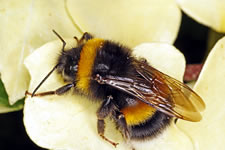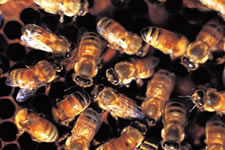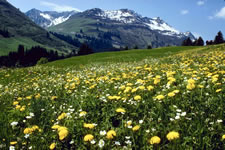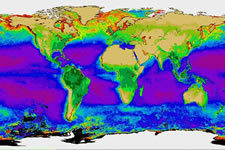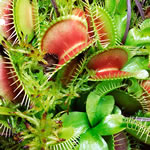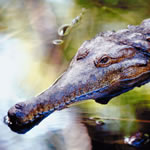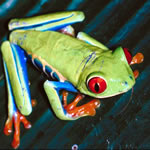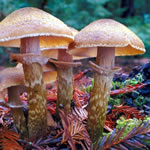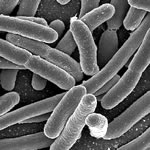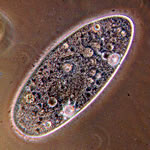Organization of Matter
You've focused on the very small to learn about atoms and chemistry and then zoomed out to learn about large earth systems and their interactions. Now we're going to hone in on life in the middle.
The hydrosphere, the geosphere, the biosphere, and the atmosphere.
The hydrologic cycle, the carbon cycle, the nitrogen cycle, the phosphorus cycle, and the sulfur cycle.
Ecologists study five major levels of organization in nature. Can you guess what they are by looking at the images below? Click each image.
- apes_bee_580x386
Organism: An individual living being.
- apes_colonyofbees_580x421
Population: A group of individuals of the same species that live in the same place at the same time.
- apes_beewithflowersaroundit_580x435
Community: All the populations of different species that live in a particular area.
- apes_alpinemeadow_580x387
Ecosystem: A community of different species interacting with one another and their nonliving environment of matter and energy.
- apes_mapoftheearth_580x290
Biosphere: All the parts of earth’s air, water, and soil where life is found.
Major Components of An Ecosystem
What are the major components of an ecosystem? Read the following website Earth on Edge: Ecosystems.
While you read, think about the biotic and abiotic components that make up an ecosystem.
Biotic and abiotic factors interact in an ecosystem. Ecology is the study of the interactions between these factors.
You saw plants and animals. What is the difference between these? Plants are photosynthetic (they produce their own food) organisms, called producers. Animals cannot make their own food. They must eat producers (plants) or other animals. They are called consumers for this reason.
There are different types of consumers: primary, secondary, and higher-level consumers. Primary consumers eat plants, while secondary consumers eat the plant-eating consumers. Third and higher-level consumers then eat those secondary consumers, and so on.
Range of Tolerance
Organisms in every ecosystem require certain physical and chemical conditions to survive. For instance, your body needs to be kept warm to survive. Imagine how miserable you'd be stuck in the Arctic with no coat!
Monarch butterflies migrate thousands of miles each year, but they are quite fragile and can only live in environments with certain physical and chemical conditions. Each population has a range of tolerance for a given physical or chemical factor. Individuals in the population may have slightly different tolerance ranges due to small differences in genetics or health.
Take a look at the National Geographic video below to find out what some of these conditions are. Think about this question, "What physical condition was pushed beyond the range of what the monarchs could tolerate?"
Monarch butterflies can only live within a certain temperature range. During a storm, temperatures plummeted in the monarch's main habitat and the majority of the butterflies died. Nearby logging may have made the monarch's habitat more susceptible to a large temperature drop.
Click on the image above to watch Monarch Butterflies or click the Monarch Butterflies link.
Limiting Factors
Every population in an ecosystem has certain needs that must be met in order for them to survive. You've seen how the range of tolerance describes the particular range of a certain physical or chemical condition required for an organism's survival. There are certain abiotic factors that can affect the number of individuals in a population. These are known as limiting factors. Limiting factors are one way of regulating population growth in nature.
These fish require certain levels of oxygen dissolved in the water, a particular temperature range, a supply of nutrients, and a specific range of salinity. These are all abiotic factors that will limit the number of fish that can survive in this population.
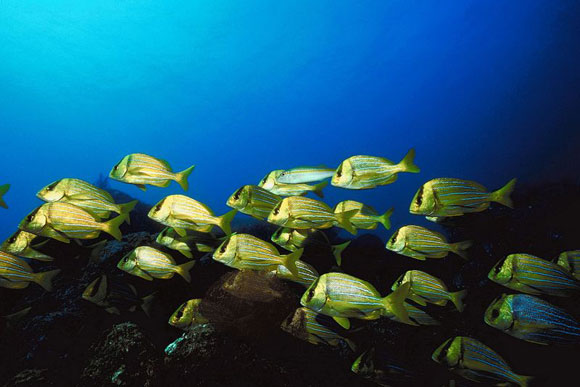
Limiting Factor Examples
Let's explore some more organisms and what limits their survival.
Although all organisms have specific biotic and abiotic requirements for survival, all organisms require food, shelter and some source of water to live.
Click each image below.
- apes_venusflytrap_386x580
Venus flytraps are limited by the moisture content of soil, pH of soil, and availability of nutrients in which to live.
- apes_hummingbird_580x387
Hummingbirds are limited by food resources, nesting habitats and environmental temperatures.
- apes_crocodile__580x387
Crocodiles are limited by food availability, habitat loss, water temperature and salinity, and high juvenile mortality.
- apes_treefrog_580x387
Frogs are often limited by proximity to water, high predation rates, high wintering mortality rate, and susceptibility to pollutants.
- apes_mushroom_580x387
Mushrooms are limited by moisture and soil conditions.
- apes_bacteria_580x488
Bacteria are found in almost all environments, including highly acidic hot springs and nuclear waste. However, they must have a food source in order to break down the nutrients to live.
- apes_paramecium_580x570
Paramecium are limited by the availability of food such as bacteria, algae and yeasts, and by the salinity level of the water.
- apes_human_387x580
Humans can adapt to many environmental changes, but are limited by food, water and shelter.
Energy Flow in Ecosystems: Food Chains
Ecosystems are sustained through a one-way flow of energy. Take a look at the series of photos shown below. What's happening to the energy in these chains?
The Second Law of Thermodynamics states that the quality of energy deteriorates over time. Energy flowing through an ecosystem can only go one way because the energy quality decreases as it moves through the ecosystem.

This food chain shows how chemical energy and nutrients move from one organism to another through trophic levels. Trophic levels represent each stage of this energy flow process. The first trophic level includes producers, like plants. The second trophic level includes primary consumers like the grasshopper. The third trophic level includes the secondary consumers, like the mouse, and so on.
![]() Reflection: Breakfast Trophic Level
Reflection: Breakfast Trophic Level
Consider your breakfast this morning (or lunch if you didn't have breakfast). At what trophic level(s) were you eating? In your science journal, describe, in order, the food chain that went into producing your breakfast today and make sure you identify the trophic level(s) involved.
Energy Flow in Ecosystems: Food Webs
Thinking back to that food chain we looked at on the last page, consider this: does the bird eat caterpillars exclusively, or does it consume a number of different organisms? What about your breakfast? Did you eat one item or was your breakfast a combination of several items? Most organisms eat more than just one item.
Text Version
Now answer the following questions about the Food Chain Animation that you just observed.
1. How can you represent a food chain when each organism consumes several different items?
2. What organism demonstrated here is in the 4th trophic level?
3. The dry weight of all the organic matter stored in a trophic level of a food web is called?
4. Why do you think there is a reduction in biomass as we move from one trophic level to the next?
5. What percentage of energy is transferred up the food chain from one trophic level to the next?
Let's Practice
Let's practice an AP-style free response question based on the material we have just learned. Using your knowledge of trophic levels and ecological efficiency explain the following:
Text Version
A vegetarian diet is one that is based on plants or primary producers. Primary producers get their energy from the sun to produce their own food. The transfer of energy is directly from the plant to the primary consumer, therefore receiving 10% of the plant's original energy. Although this seems like a small percentage, this is the highest level of ecological efficiency in the system. As food travels up the food chain to higher trophic levels, the ecological efficiency decreases with less and less energy passed along to the consumer. Eating lower on the food chain is more efficient because energy is lost from transfer between trophic levels.
More energy is present at lower trophic levels than higher ones. The ecological efficiency is approximately 10%, with a variation from 4%-40% in some systems. This means as you move from trophic level 1 to trophic level 2, only 10% of the energy is transferrable. The rest is lost as heat or unusable by the organism. A given amount of solar energy will sustain more people when it is consumed as grain than when that grain is fed to livestock to be consumed.

